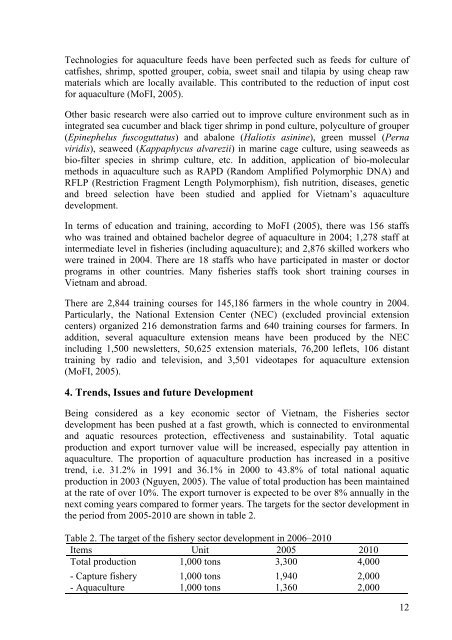AN OVERVIEW OF AQUACULTURE SECTOR IN VIETNAM - Library
AN OVERVIEW OF AQUACULTURE SECTOR IN VIETNAM - Library
AN OVERVIEW OF AQUACULTURE SECTOR IN VIETNAM - Library
You also want an ePaper? Increase the reach of your titles
YUMPU automatically turns print PDFs into web optimized ePapers that Google loves.
Technologies for aquaculture feeds have been perfected such as feeds for culture ofcatfishes, shrimp, spotted grouper, cobia, sweet snail and tilapia by using cheap rawmaterials which are locally available. This contributed to the reduction of input costfor aquaculture (MoFI, 2005).Other basic research were also carried out to improve culture environment such as inintegrated sea cucumber and black tiger shrimp in pond culture, polyculture of grouper(Epinephelus fuscoguttatus) and abalone (Haliotis asinine), green mussel (Pernaviridis), seaweed (Kappaphycus alvarezii) in marine cage culture, using seaweeds asbio-filter species in shrimp culture, etc. In addition, application of bio-molecularmethods in aquaculture such as RAPD (Random Amplified Polymorphic DNA) andRFLP (Restriction Fragment Length Polymorphism), fish nutrition, diseases, geneticand breed selection have been studied and applied for Vietnam’s aquaculturedevelopment.In terms of education and training, according to MoFI (2005), there was 156 staffswho was trained and obtained bachelor degree of aquaculture in 2004; 1,278 staff atintermediate level in fisheries (including aquaculture); and 2,876 skilled workers whowere trained in 2004. There are 18 staffs who have participated in master or doctorprograms in other countries. Many fisheries staffs took short training courses inVietnam and abroad.There are 2,844 training courses for 145,186 farmers in the whole country in 2004.Particularly, the National Extension Center (NEC) (excluded provincial extensioncenters) organized 216 demonstration farms and 640 training courses for farmers. Inaddition, several aquaculture extension means have been produced by the NECincluding 1,500 newsletters, 50,625 extension materials, 76,200 leflets, 106 distanttraining by radio and television, and 3,501 videotapes for aquaculture extension(MoFI, 2005).4. Trends, Issues and future DevelopmentBeing considered as a key economic sector of Vietnam, the Fisheries sectordevelopment has been pushed at a fast growth, which is connected to environmentaland aquatic resources protection, effectiveness and sustainability. Total aquaticproduction and export turnover value will be increased, especially pay attention inaquaculture. The proportion of aquaculture production has increased in a positivetrend, i.e. 31.2% in 1991 and 36.1% in 2000 to 43.8% of total national aquaticproduction in 2003 (Nguyen, 2005). The value of total production has been maintainedat the rate of over 10%. The export turnover is expected to be over 8% annually in thenext coming years compared to former years. The targets for the sector development inthe period from 2005-2010 are shown in table 2.Table 2. The target of the fishery sector development in 2006–2010Items Unit 2005 2010Total production 1,000 tons 3,300 4,000- Capture fishery 1,000 tons 1,940 2,000- Aquaculture 1,000 tons 1,360 2,00012
















